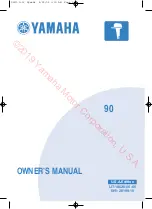
TS-5300 User’s Manual
Technologic Systems
05/21/09
12
The TS-5300 BIOS incorporates a fairly complete set of
INT10h video routines that work with the LCD. Once the
LCD has been enabled (
INT15h/Func B042h
– see
Appendix E below)
The LCD can be written to as the standard I/O device. This
means that software can be developed and debugged
using standard I/O calls, and the executable will work with
LCD, VGA video, or redirected COM port. See the section
16 for more information.
I/O addresses
72h
and
73h
are used to access the LCD.
Figure 6
shows the header pin-out, while Table 3 lists the
LCD signals. The section below will briefly describe the
LCD interface signals. The LCD can be controlled directly
by software at these addresses.
The register select signal is simply the buffered A0 address
line. Thus, reads and writes to
72h
cause register select to
be low, and those to
73h
cause it to be high. Generally the
LCD uses this line to separate data bytes from command
bytes. See your LCD data sheet for details.
The LCD Write# signal is an active low write enable line.
LCD Enable is an active high signal, raised whenever the
LCD addresses are being read or written.
D0 – D7 are bi-directional, buffered copies of the data bus and carry all data and commands to the LCD.
Table 3 is not the standard pin-outs given for LCD displays. But this pin-out allows a standard ribbon
cable to be used when the ribbon cable is attached to the
backside
of the LCD.
Example LCD code is available at:
ftp://ftp.embeddedarm.com/old/downloads/UTIL.ZIP
8 Matrix Keypad Support
The DIO2 port, signals DIO2_0 through DIO2_7, may be configured to support a 4 x 4 matrix keypad.
When enabled, BIOS firmware performs all the work, making the matrix keypad appear as a simple 16-
key keyboard to software. This allows the use of standard keyboard access routines. The default set of
keys translated by the BIOS consists of 0 – 9, A – D, *, and #. The # key is returned as an ASCII
Carriage Return character (Hex 0D). Because the user is writing the software, this set of keys is usually
sufficient. However, a custom translation table can be loaded, allowing the use of function keys, arrow
keys, or any other key on the keyboard.
Matrix keypad support is enabled or disabled using
INT15h, Function B040h
(see Appendix F). Once
enabled, standard keyboard BIOS functions are enabled. Note that console redirection and the matrix
keypad support are mutually exclusive – console redirection must be disabled to use the keypad.
A matrix keypad can be used with console redirection only if the keypad is not used as stdin, but read
from as a hardware device. This is useful if one wishes to use console redirection or to use a keyboard
as stdin. See section 16 for an explanation of console I/O and redirection. See the Technologic Systems
download page for example code.
ftp://ftp.embeddedarm.com/old/downloads/KEYPAD.ZIP
When using a matrix keypad, the DIO2 signals DIO2_0 through DIO2_7 are not available as general I/O.
Pin
Function
Comments
1
LCD 5V
2
LCD GND
3
LCD_RS
Register Select
(Buffered A0)
4
Bias
680 Ohm to GND
5
LCD_EN
Active high Enable
6
LCD_WR# Active low Write
7
LCD_D1
8
LCD_D0
9
LCD_D3
10
LCD_D2
11
LCD_D5
12
LCD_D4
13
LCD_D7
14
LCD_D6
D0 – D7: Buffered
bi-directional data bus
Table 3 - LCD Header Signals
Summary of Contents for TS-5300
Page 1: ...TS 5300 User s Manual...













































